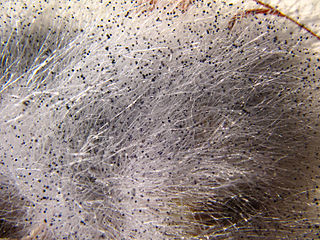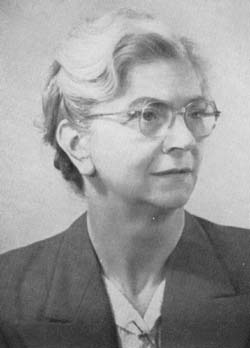
Cryptococcus is a genus of fungi in the family Cryptococcaceae that includes both yeasts and filamentous species. The filamentous, sexual forms or teleomorphs were formerly classified in the genus Filobasidiella, while Cryptococcus was reserved for the yeasts. Most yeast species formerly referred to Cryptococcus have now been placed in different genera. The name Cryptococcus comes from the Greek for "hidden sphere". Some Cryptococcus species cause a disease called cryptococcosis.
Gordon Herriot Cunningham, CBE, FRS was the first New Zealand–based mycologist and plant pathologist. In 1936 he was appointed the first director of the DSIR Plant Diseases Division. Cunningham established the New Zealand Fungal Herbarium, and he published extensively on taxonomy of many fungal groups. He is regarded as the 'Father' of New Zealand mycology.
Exophiala jeanselmei is a saprotrophic fungus in the family Herpotrichiellaceae. Four varieties have been discovered: Exophiala jeanselmei var. heteromorpha, E. jeanselmei var. lecanii-corni, E. jeanselmei var. jeanselmei, and E. jeanselmei var. castellanii. Other species in the genus Exophiala such as E. dermatitidis and E. spinifera have been reported to have similar annellidic conidiogenesis and may therefore be difficult to differentiate.

Blastomyces dermatitidis is a dimorphic fungus that causes blastomycosis, an invasive and often serious fungal infection found occasionally in humans and other animals. It lives in soil and wet, decaying wood, often in an area close to a waterway such as a lake, river or stream. Indoor growth may also occur, for example, in accumulated debris in damp sheds or shacks. The fungus is endemic to parts of eastern North America, particularly boreal northern Ontario, southeastern Manitoba, Quebec south of the St. Lawrence River, parts of the U.S. Appalachian mountains and interconnected eastern mountain chains, the west bank of Lake Michigan, the state of Wisconsin, and the entire Mississippi Valley including the valleys of some major tributaries such as the Ohio River. In addition, it occurs rarely in Africa both north and south of the Sahara Desert, as well as in the Arabian Peninsula and the Indian subcontinent. Though it has never been directly observed growing in nature, it is thought to grow there as a cottony white mold, similar to the growth seen in artificial culture at 25 °C (77 °F). In an infected human or animal, however, it converts in growth form and becomes a large-celled budding yeast. Blastomycosis is generally readily treatable with systemic antifungal drugs once it is correctly diagnosed; however, delayed diagnosis is very common except in highly endemic areas.

A fungus is any member of the group of eukaryotic organisms that includes microorganisms such as yeasts and molds, as well as the more familiar mushrooms. These organisms are classified as one of the traditional eukaryotic kingdoms, along with Animalia, Plantae, and either Protista or Protozoa and Chromista.
Michael Francis Madelin (1931–2007) was a British mycologist. He held research faculty positions at Imperial College, University of London, and the University of Bristol, and undertook pioneering research in conidial fungi and slime moulds, with specific reference to their physiology and ecology.
Moniliella is a genus of fungi in the subdivision Ustilaginomycotina. It is in the monotypic family MoniliellaceaeQ.M. Wang, F.Y. Bai & Boekhout, which is in the monotypic order MoniliellalesQ.M. Wang, F.Y. Bai & Boekhout which is in the monotypic class MoniliellomycetesQ.M. Wang, F.Y. Bai & Boekhout.

The Belgian Co-ordinated Collections of Micro-organisms (BCCM) is a Belgian government funded consortium of seven scientific institutions, who manage and exploit a collection of microbial and genetic resources. The consortium comprises more than 269,000 publicly available strains of bacteria including mycobacteria and cyanobacteria, filamentous fungi, yeasts, diatoms and plasmids.

Panellus stipticus, commonly known as the bitter oyster, the astringent panus, the luminescent panellus, or the stiptic fungus, is a species of fungus. It belongs in the family Mycenaceae, and the type species of the genus Panellus. A common and widely distributed species, it is found in Asia, Australia, Europe, and North America, where it grows in groups or dense overlapping clusters on the logs, stumps, and trunks of deciduous trees, especially beech, oak, and birch. During the development of the fruit bodies, the mushrooms start out as tiny white knobs, which, over a period of one to three months, develop into fan- or kidney-shaped caps that measure up to 3 cm (1.2 in) broad. The caps are orange-yellow to brownish, and attached to the decaying wood by short stubby stalks that are connected off-center or on the side of the caps. The fungus was given its current scientific name in 1879, but has been known by many names since French mycologist Jean Bulliard first described it as Agaricus stypticus in 1783. Molecular phylogenetic analysis revealed P. stipticus to have a close genetic relationship with members of the genus Mycena.

Alma Joslyn Whiffen-Barksdale was an American mycologist who discovered cycloheximide. She was born in Hammonton, New Jersey. She received a bachelor's degree from Maryville College (1937). Her Masters and Ph.D. were earned at the University of North Carolina. In 1941–42. She was a Carnegie Fellow, and in 1951, she was a Guggenheim Fellow. Barksdale worked at the Department of Antibiotic Research of the Upjohn Company of Kalamazoo, Michigan (1943–52) and at the New York Botanical Garden. Barksdale became a foundational figure in the study of Achlya, a genus of aquatic fungi with a unique reproductive system, while working at the New York Botanical Garden; The Mycological Society of America and the Achlya Newsletter, a publication of continuing research on Achlya, both published retrospectives on her life and work following her death in 1981.

Exophiala phaeomuriformis is thermophilic fungus belonging to the genus Exophiala and the family Herpotrichiellaceae. it is a member of the group of fungi known as black yeasts, and is typically found in hot and humid locations, such as saunas, bathrooms, and dishwashers. This species can cause skin infections and is typically classified as a Biosafety Risk Group 2 agent.
Kenneth A. Harrison was a Canadian mycologist. He was for many years a plant pathologist at what is now the Atlantic Food and Horticulture Research Centre in Nova Scotia. After retirement, he contributed to the taxonomy of the Agaricomycotina, particularly the tooth fungi of the families Hydnaceae and Bankeraceae, in which he described several new species.
Luella Kayla Weresub, Ph.D. was a world authority on the botanical nomenclature of fungi, especially corticioid fungi and sclerotium-producing basidiomycetes. She was a mycologist at the Central Experimental Farm, Ottawa, with Canada’s federal department of agriculture. Her influence on Canadian mycology and her concern with public education are recognized in the Canadian Botanical Association’s annual Luella K. Weresub lecture in Mycology and the Weresub Prize awarded for the best student paper published by a Canadian student in mycology.

Rhizopus stolonifer is commonly known as black bread mold. It is a member of Zygomycota and considered the most important species in the genus Rhizopus. It is one of the most common fungi in the world and has a global distribution although it is most commonly found in tropical and subtropical regions. It is a common agent of decomposition of stored foods. Like other members of the genus Rhizopus, R. stolonifer grows rapidly, mostly in indoor environments.

John Waldo Taylor is an American scientist who researches fungal evolution and ecology. He is professor of the graduate school in the Department of Plant and Microbial Biology at the University of California, Berkeley.
Rhoda Williams Benham was an American mycologist, taxonomist, and pioneer of the field of medical mycology. Throughout her career, she taught and trained many medical mycologists at Columbia University, while also conducting and publishing fundamental research in the field. Her most renowned works include her publications on the genus Candida, which established her as an authority on the yeast-like fungi pathogenic to man.

Lilian Edith Hawker was a British mycologist, known for her work on fungal physiology, particularly spore production. She was an expert on British truffles, and also published in the fields of plant physiology and plant pathology. She was also known for her contributions to education in mycology. Most of her career was spent at the botany department of the Imperial College of Science and Technology (1932–45) and the University of Bristol (1945–73), where she held the chair in mycology (1965–73) and was dean of the science faculty (1970–73). She served as president of the British Mycological Society, and was elected an honorary member of that society and of the Mycological Society of America. She published an introduction to fungi and two books on fungal physiology, of which Physiology of Fungi (1950) was among the first to survey the field, and also co-edited two microbiology textbooks.

Chester Wilson Emmons was an American scientist, who researched fungi that cause diseases. He was the first mycologist at the National Institutes of Health (NIH), where for 31 years he served as head of its Medical Mycology Section.

Fungi are a common theme and working material in art. Fungi appear in nearly all art forms, including literature, paintings, and graphic arts; and more recently, contemporary art, music, photography, comic books, sculptures, video games, dance, cuisine, architecture, fashion, and design. There are some exhibitions dedicated to fungi, as well as an entire museum.
In mycology, a dark taxon is a taxon that does not appear to produce any observable morphological structure and that appears impossible to cultivate in laboratory conditions. Dark taxa are chiefly detected by DNA sequencing, and in particular environmental metabarcoding.












